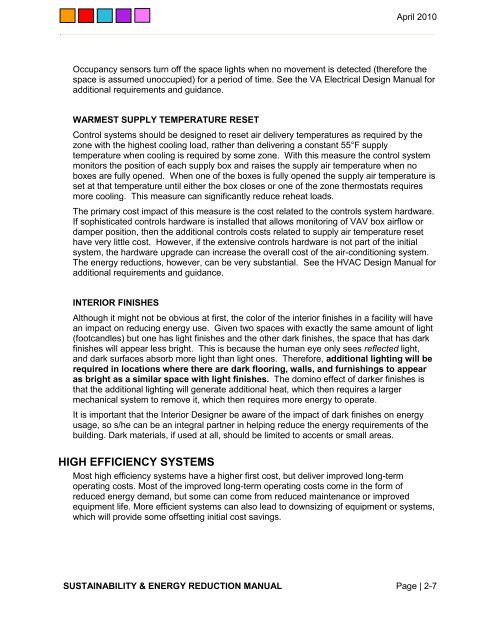Sustainability Design and Energy Reduction Manual - The Whole ...
Sustainability Design and Energy Reduction Manual - The Whole ...
Sustainability Design and Energy Reduction Manual - The Whole ...
You also want an ePaper? Increase the reach of your titles
YUMPU automatically turns print PDFs into web optimized ePapers that Google loves.
April 2010<br />
Occupancy sensors turn off the space lights when no movement is detected (therefore the<br />
space is assumed unoccupied) for a period of time. See the VA Electrical <strong>Design</strong> <strong>Manual</strong> for<br />
additional requirements <strong>and</strong> guidance.<br />
WARMEST SUPPLY TEMPERATURE RESET<br />
Control systems should be designed to reset air delivery temperatures as required by the<br />
zone with the highest cooling load, rather than delivering a constant 55°F supply<br />
temperature when cooling is required by some zone. With this measure the control system<br />
monitors the position of each supply box <strong>and</strong> raises the supply air temperature when no<br />
boxes are fully opened. When one of the boxes is fully opened the supply air temperature is<br />
set at that temperature until either the box closes or one of the zone thermostats requires<br />
more cooling. This measure can significantly reduce reheat loads.<br />
<strong>The</strong> primary cost impact of this measure is the cost related to the controls system hardware.<br />
If sophisticated controls hardware is installed that allows monitoring of VAV box airflow or<br />
damper position, then the additional controls costs related to supply air temperature reset<br />
have very little cost. However, if the extensive controls hardware is not part of the initial<br />
system, the hardware upgrade can increase the overall cost of the air-conditioning system.<br />
<strong>The</strong> energy reductions, however, can be very substantial. See the HVAC <strong>Design</strong> <strong>Manual</strong> for<br />
additional requirements <strong>and</strong> guidance.<br />
INTERIOR FINISHES<br />
Although it might not be obvious at first, the color of the interior finishes in a facility will have<br />
an impact on reducing energy use. Given two spaces with exactly the same amount of light<br />
(footc<strong>and</strong>les) but one has light finishes <strong>and</strong> the other dark finishes, the space that has dark<br />
finishes will appear less bright. This is because the human eye only sees reflected light,<br />
<strong>and</strong> dark surfaces absorb more light than light ones. <strong>The</strong>refore, additional lighting will be<br />
required in locations where there are dark flooring, walls, <strong>and</strong> furnishings to appear<br />
as bright as a similar space with light finishes. <strong>The</strong> domino effect of darker finishes is<br />
that the additional lighting will generate additional heat, which then requires a larger<br />
mechanical system to remove it, which then requires more energy to operate.<br />
It is important that the Interior <strong>Design</strong>er be aware of the impact of dark finishes on energy<br />
usage, so s/he can be an integral partner in helping reduce the energy requirements of the<br />
building. Dark materials, if used at all, should be limited to accents or small areas.<br />
HIGH EFFICIENCY SYSTEMS<br />
Most high efficiency systems have a higher first cost, but deliver improved long-term<br />
operating costs. Most of the improved long-term operating costs come in the form of<br />
reduced energy dem<strong>and</strong>, but some can come from reduced maintenance or improved<br />
equipment life. More efficient systems can also lead to downsizing of equipment or systems,<br />
which will provide some offsetting initial cost savings.<br />
SUSTAINABILITY & ENERGY REDUCTION MANUAL Page | 2-7

















